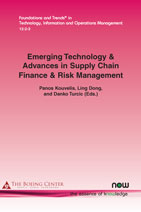Optimal Positioning in the Derivative Market: Review, Foundations, and Trends
By Paolo Guiotto, University of Padova, Italy, paolo.guiotto@unipd.it | Andrea Roncoroni, ESSEC Business School, France, roncoroni@essec.edu
Abstract
We review the theoretical development of optimal positioning in financial derivatives for managing corporate exposure. Our primary focus is on one-period integrated financial-operational policies featuring a bespoke financial contingent claim (or portfolio of claims) and an operational control variable. We develop a unifying theoretical framework which (a) encompasses all of existing solutions in a static set-up across the areas of of portfolio insurance, agricultural economics, and integrated financial-operational management, (b) provides researchers with a solid ground to either fill in gaps in the current literature and move forward towards a general theory of contingent claim origination. We also put forward pathways for future development, one based on current research problem, the other focusing on new methodological issue.
Emerging Technology & Advances in Supply Chain Finance & Risk Management
Emerging Technology & Advances in Supply Chain Finance & Risk Management reflects the state-of-the-art in research thought leadership in supply chain finance and risk management, and it contains great expository pieces on how advanced technologies are shaping supply chains and risk management within them. You will also find ideas on how supply chain finance and risk management can be best taught in our classrooms.
The volume is divided into three parts, each part reflecting a major active research area of the field including: Part 1: Supply Chain Finance; Part 2: Financial Hedging and Commodity Risks; Part 3: Operational Strategies and Risk Management.
Part 1 deals with the broad area of supply chain finance and programs that will better allow for working capital management within supply chains. Part 2 introduces concepts of hedging financial and operational risks due to uncertain commodity prices, fluctuating exchange rates, and volatile interest rates. Emphasis is placed on understanding how financial hedges can be used for hedging relevant supply chain risks in a way that reflects modern view of financial risk management. Part 3 examines topics and solution approaches reflecting the more traditional treatments in the contemporary literature of operational and supply chain risks. This volume provides rich implications for future research directions in efforts to master the new complexities and uncertainties of the global business environment and better understand the impact of advanced technologies in global supply chains.

Companion
Foundations and Trends® in Technology, Information and Operations Management, Volume 12, Issue 2-3 Special Issue: Emerging Technology & Advances in Supply Chain Finance & Risk Management
See the other articles that are also part of this special issue.